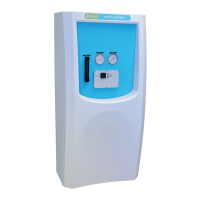115.6031.0 - 14 -
2 INSTALLATION
Select a location which can be isolated from unauthorized personnel. The selected location should be indoors where
the ambient temperature does not fall below freezing.
Select a well ventilated room provided with a source of heat to maintain an ambient temperature above freezing at
all times for Chlorine and Ammonia, and above 70°F for Sulfur Dioxide. The minimum temperature must be above
32°F to prevent freezing of the water system. To provide maximum safety for operating personnel, the room should
have access doors only from the outside and should contain no connecting doorways to internal areas in the event
of a gas leak. The room should be equipped and tted as described under the Personnel Safety Section in Instruction
Bulletin 70-9001.
The selected location must be of sucient size and the Vaporizer so positioned to provide the minimum required
clearances as specied in outline dimension drawings Figures 4 or 5 (whichever is applicable) to allow easy access
for routine inspection, maintenance and cleaning. To assist in removing the vaporizing chamber for cleaning and
inspection, it is strongly recommended that a permanent hoist structure be erected over the center of the Vaporizer
for mounting and supporting the weight and load of a one-ton capacity chain hoist plus chamber. The elevation of
the base of this structure must be determined by adding the required clearance and mounting dimensions of the
chain hoist to the specied minimum headroom requirement for removing the vaporizing chamber. In lieu of a
permanent hoist structure, a temporary hoist structure may be used that meets the structural and dimensional
requirements of the specic site conditions.
The cabinet must be removed until the Vaporizer System is completely checked out and proven operational.
The Vaporizer should be mounted plumb and level on a rm, well supported foundation. Four 1 inch diameter holes
are provided at the corners of the water jacket base plate for mounting bolts or studs. Studs, if used, should project
1-3/8 inch above the mounting surface.
Pipe the liquid chemical inlet and gas outlet connections as illustrated in Figure 2, and construct the water supply,
drain and overow piping in accordance with the information provided in Figure 3. Piping is supplied by the user.
Plumbing must be in accordance with local codes.
All pressurized chemical carrying pipes and ttings must be Schedule 80 seamless steel or forged steel conforming to
ASTM A-105 and A-106, Grade B.
All piping, valves and ttings must be thoroughly cleaned of all oils and foreign matter prior to assembly in
accordance with Chlorine Institute Pamphlet #6. Failure to do so may result in a combustible reaction. Steam is the
best method of cleaning, but chlorinated solvents are also acceptable if used in conjunction with the manufacturer's
and environmental agency safety recommendations.
Prior to assembly, threads on all chemical carrying pipes and ttings should be wrapped with Teon tape or a pipe
dope approved for Chlorine gas and liquid service.
The minimum acceptable size (3/4 inch) of the pressure reducing and shut-o valve must be based on the manufac-
turers’ recommendations as related to the total gas feed rate requirements of the gas dispensing system. Meeting
the close coupling requirement as illustrated and noted in Figure 2, (i. e., holding the pipe run between the
Vaporizer and this valve to an absolute minimum) will prevent liquefaction (gas vapors condensing to form liquid
chemical) from occurring within this portion of the gas piping. If space limitations prevent the possibility of
meeting this requirement, it will be necessary to mount the valve at a slightly higher elevation than shown and
slope the interconnecting pipe run upward to allow any condensed gas vapors to ow back into the Vaporizer. This
would prevent liquid chemical from entering and “ashing” across the valve seat. It is recommended that the piping
run between the Vaporizer and the pressure reducing valve be insulated.

